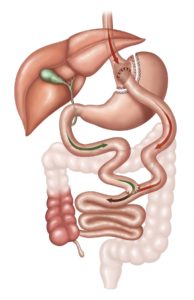Roux-en-Y gastric bypass is one of the most frequently performed procedures for obesity in the U.S. It was developed to limit the amount of food consumed, but also induces metabolic changes to decrease hunger and increase metabolism. Roux-en-Y gastric bypass is a restrictive and metabolic  procedure.
procedure.
1. The stomach is converted to a smaller stomach pouch that holds approximately 60 milliliters, equivalent to approximately 2 ounces or a 1/4 cup. This limits the amount of food that can be eaten (restrictive), and with combined hormone changes, patients feel full and satisfied from small meals.
2. The small bowel is divided about two feet from the stomach. One end is brought up and attached to the small stomach pouch. The other end of the small intestine is reconnected to the intestinal tract and is a route for digestive enzymes. Food is routed past most of the stomach and the first part of the small intestine, resulting in metabolic changes that lead to beneficial hormone stabilization and the resolution of metabolic syndromes, including type II diabetes, high blood pressure, and high cholesterol.
Almost all gastric bypass procedures performed today use a minimally invasive laparoscopic technique. The entire procedure is done through small incisions in the abdomen, an overnight stay is required, and most patients are discharged the day after surgery.












 Address: 1521 East 3900 South STE 100
Address: 1521 East 3900 South STE 100 Office: +
Office: +  Fax number (801) 268-3997
Fax number (801) 268-3997 Email: info@rmapinc.com
Email: info@rmapinc.com



